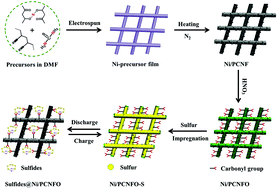Porous nitrogen-doped carbon nanofibers assembled with nickel nanoparticles for lithium–sulfur batteries†
Abstract
High-efficiency cathodes in lithium–sulfur (Li–S) batteries play an important role in the pursuit of high electrochemical performance. However, a number of Li–S batteries currently reported suffer from severe drawbacks such as the insulating nature of sulfur, sluggish redox kinetics, and the shuttle effect of intermediate polysulfides. To overcome these challenges, herein, carbonyl group functionalized porous carbon nanofibers assembled with nickel (Ni/PCNFO) are proposed to serve as an efficient sulfur host in Li–S batteries. Such a Ni/PCNFO-S composite cathode exhibits outstanding electrochemical performances, which are attributed to three factors: (1) the large inner space of the PCNF can afford a high S content and accommodate the volume expansion; (2) high electrical conductivity is provided by the carbon nanofiber skeleton and the electrocatalytically active Ni species embedded in the PCNF significantly facilitate the redox kinetics of the S species; and (3) the carbonyl group anchored on the Ni/PCNF can effectively suppress the polysulfide effect via strong chemical affinity/adsorption with polysulfides. With these advantageous features, the Li–S batteries based on Ni/PCNFO-S cathodes exhibit a high specific capacity (1320 mA h g−1), excellent rate capability (780 mA h g−1), and long cycling stability (910 mA h g−1 after 500 cycles at 0.2C).



 Please wait while we load your content...
Please wait while we load your content...